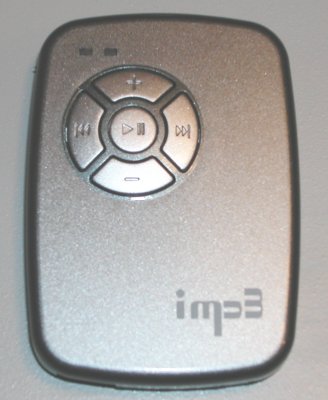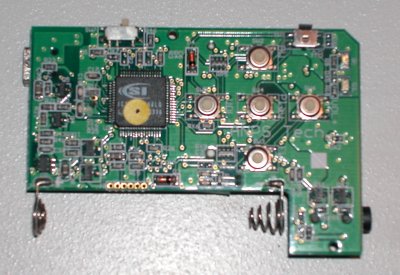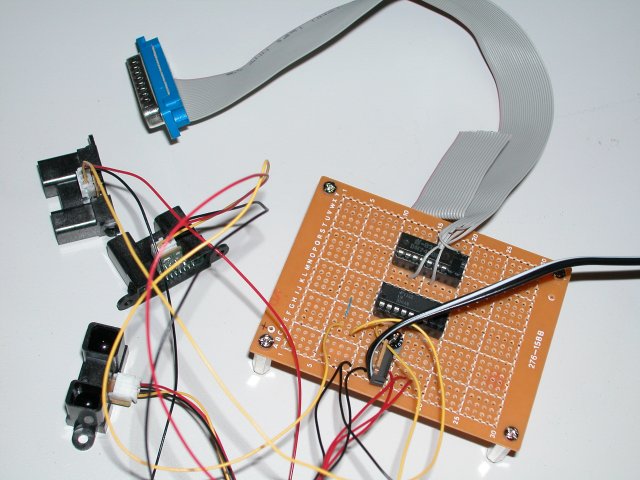Note to self: forget the 7805, instead go for the pin-compatible LM2937 which only needs 5.5V input to provide a regulated 5.0V output up to 500mA. This actually would be nice if I ever rebuild Sycophant, because a lot of RC cars run on 6V, which isn't quite enough for a good 5V from a 7805.
Meanwhile I think I've found a nice H-Bridge circuit, I have to double check that the Saturn windshield wiper motor doesn't pull more than 4A from my 12V supply. I'll have a PIC microcontroller do PWM through it and have the motor go back and forth to move the arm for Blame.
Thursday, September 29, 2005
Monday, September 26, 2005
Cheaper Sonar
Acroname now has a $25 sonar sensor which senses up to 4 meters. Documentation is available here.
I tested the Saturn windshield wiper last night with my big-Amp 12V supply. Looks good, tons of torque, but even the slowest setting may still be too fast. A DC motor controller circuit may be in my future.
I tested the Saturn windshield wiper last night with my big-Amp 12V supply. Looks good, tons of torque, but even the slowest setting may still be too fast. A DC motor controller circuit may be in my future.
Sunday, September 25, 2005
Saturn Motor
I just purchased a Saturn windshield wiper from BG Micro to drive the pointing hand for Blame.
I had a good chat with Scott today about the eyes project...things are looking good!
I had a good chat with Scott today about the eyes project...things are looking good!
Thursday, September 22, 2005
Cheap Small MP3 Player
When I originally installed Sycophant at Art-O-Matic 2004, I used a small Fujitsu Stylistic 1200 pen-based PC to provide the audio using WAV files played back when the PIC microcontroller on the head requested audio through a parallel port signal. The audio was great! But I had problems with the PC crashing, long boot times, etc.
When I went to show Sycophant at the Fraser Gallery, I decided to use a Windbond chipcorder as a solid-state way of doing the audio and getting rid of the PC. The system was now very solid and came on within one second of power-up. But the audio sounded pretty bad.
My next project, Blame, will involve an arm swinging back and forth, stopping when pointing at a person, and blaming them for something horrible (global warming, war, loss of morals, sexual promiscuity, etc.) I wanted better audio, so I looked around for a cheap flash-based MP3 player I could hack for the project to replace the chipcorder.
At Flash Memory Store, which has all kinds of digital storage products, I found the IMP3 SD/MMC card-based MP3 player, which also has a thumb-drive style USB interface. It looks like I can just hook up some N-FETs across the push-switches to drive it. Here are some pictures:


When I went to show Sycophant at the Fraser Gallery, I decided to use a Windbond chipcorder as a solid-state way of doing the audio and getting rid of the PC. The system was now very solid and came on within one second of power-up. But the audio sounded pretty bad.
My next project, Blame, will involve an arm swinging back and forth, stopping when pointing at a person, and blaming them for something horrible (global warming, war, loss of morals, sexual promiscuity, etc.) I wanted better audio, so I looked around for a cheap flash-based MP3 player I could hack for the project to replace the chipcorder.
At Flash Memory Store, which has all kinds of digital storage products, I found the IMP3 SD/MMC card-based MP3 player, which also has a thumb-drive style USB interface. It looks like I can just hook up some N-FETs across the push-switches to drive it. Here are some pictures:


Monday, September 19, 2005
Forget 7805's
Well, I am now done with linear voltage regulators like the 7805. For some reason, it could only hold the circuit at 4.7 V with some significant irregularity, even when fed with 12VDC. The IR sensors were not very stable at the slightly lower voltage, and the output digital levels were not solid.
So I swapped out the 7805 for a Cosel YS505U "Gorilla" AC-to-DC converter I had laying around. Now I have a nice solid 5V of up to 1A, and everything is happy. The IR sensors are now responding properly, and my Visual Basic program can read them through the parallel port input.
Tommorow night I am going to work on the software a bit, hopefully to include some sound along with the animated eyes. Scott may be coming over Wednesday to see the progress. He's been painting new eyes.
On another note, Jesse from ArtDC.Org sent me a link to Noboru Tsubaki's work that includes a large fiberglass insect that lures visitors into its "web". His UN Boy project includes a 16-foot tall Teddy Bear and a mine-clearing robot.
So I swapped out the 7805 for a Cosel YS505U "Gorilla" AC-to-DC converter I had laying around. Now I have a nice solid 5V of up to 1A, and everything is happy. The IR sensors are now responding properly, and my Visual Basic program can read them through the parallel port input.
Tommorow night I am going to work on the software a bit, hopefully to include some sound along with the animated eyes. Scott may be coming over Wednesday to see the progress. He's been painting new eyes.
On another note, Jesse from ArtDC.Org sent me a link to Noboru Tsubaki's work that includes a large fiberglass insect that lures visitors into its "web". His UN Boy project includes a 16-foot tall Teddy Bear and a mine-clearing robot.
Sunday, September 18, 2005
New Eyes Circuit
Welcome to my new Tech Art blog! I decided that I want to keep a separate blog dedicated to my art projects, and other cool tech artwork, for my own reference and the elucidation of others.
To bring you up to speed, I am working on a collaboration with painter/video artist Scott Hutchison. It will be a slot where computer projected images of eyes will follow you as you walk by the work. The eyes will actually be Scott's eyes, as painted and animated by him. My part to play is the sensor work and software behind it.
Here is an image of the wire-wrap board for the Eyes project. Right now there is just a 7805 5V regulator, a potentiometer to set the distance desired for the sensors, the three Sharp GP2Y0A02YK long-range IR distance sensors (long-range being 5 feet...) an LM324 analog comparator chip (which compares the analog distance voltage to the potentiometer voltage) and a 7408 quad 2-input AND chip used as a buffer to help drive the digital parallel port inputs.

By the way, check out Scott's work here:

To bring you up to speed, I am working on a collaboration with painter/video artist Scott Hutchison. It will be a slot where computer projected images of eyes will follow you as you walk by the work. The eyes will actually be Scott's eyes, as painted and animated by him. My part to play is the sensor work and software behind it.
Here is an image of the wire-wrap board for the Eyes project. Right now there is just a 7805 5V regulator, a potentiometer to set the distance desired for the sensors, the three Sharp GP2Y0A02YK long-range IR distance sensors (long-range being 5 feet...) an LM324 analog comparator chip (which compares the analog distance voltage to the potentiometer voltage) and a 7408 quad 2-input AND chip used as a buffer to help drive the digital parallel port inputs.

By the way, check out Scott's work here:

Subscribe to:
Posts (Atom)